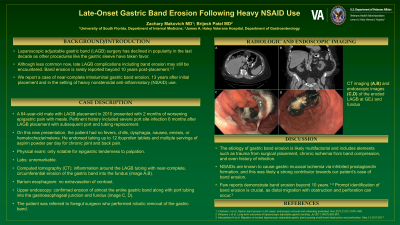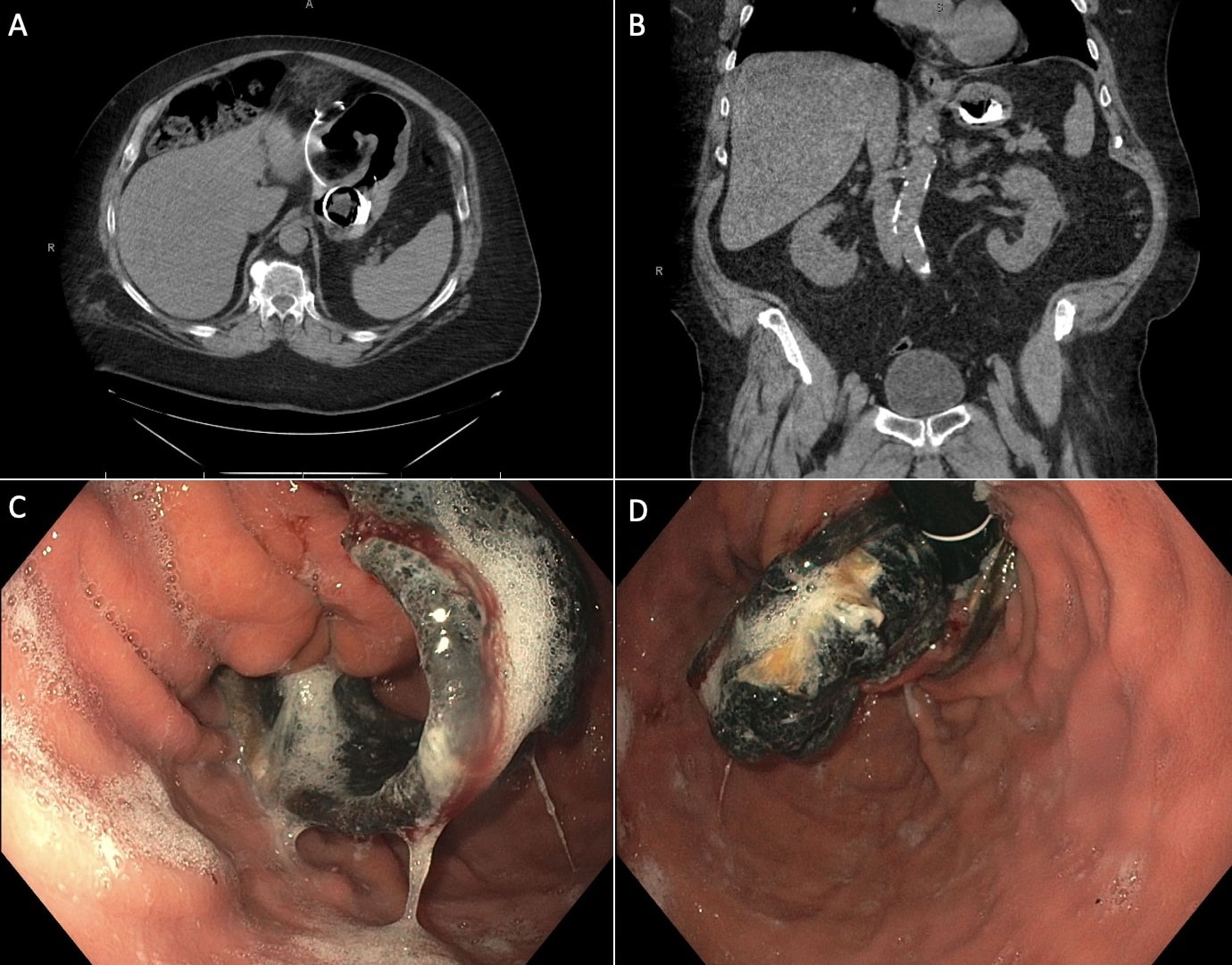Sunday Poster Session
Category: Obesity
P1170 - Late-Onset Gastric Band Erosion Following Heavy NSAID Use
Sunday, October 22, 2023
3:30 PM - 7:00 PM PT
Location: Exhibit Hall

Has Audio

Zachary Makovich, MD
University of South Florida
Tampa, FL
Presenting Author(s)
Zachary Makovich, MD, Brijesh Patel, MD
University of South Florida, Tampa, FL
Introduction: Laparoscopic adjustable gastric band (LAGB) surgery has declined in popularity in the last decade as other procedures like the gastric sleeve have taken favor. Although less common now, late LAGB complications including band erosion may still be encountered. Band erosion is rarely reported beyond 10 years post-placement.1-3 We report a case of near-complete intraluminal gastric band erosion, 13 years after initial placement and in the setting of heavy nonsteroidal anti-inflammatory (NSAID) use.
Case Description/Methods: A 64-year-old male with LAGB placement in 2010 presented with 2 months of worsening epigastric pain with meals. Pertinent history included severe port site infection 6 months after LAGB placement with subsequent port and tubing replacement. On this new presentation, the patient had no fevers, chills, dysphagia, nausea, emesis, or hematochezia/melena. He endorsed taking up to 12 ibuprofen tablets and multiple servings of aspirin powder per day for chronic joint and back pain.
Physical exam was only notable for epigastric tenderness to palpation. Labs were unremarkable. Computed tomography showed inflammation around the LAGB tubing with near-complete, circumferential erosion of the gastric band into the fundus. Barium esophogram did not reveal extravasation of contrast. Subsequently, upper endoscopy was performed and confirmed erosion of almost the entire gastric band along with port tubing into the gastroesophageal junction and fundus. The patient was referred to surgical colleagues who performed robotic removal of the gastric band.
Discussion: Few reports demonstrate LAGB erosion beyond 10 years.1-3 Prompt identification of band erosion is crucial, as distal migration with obstruction and perforation can occur.3 The etiology of gastric band erosion is likely multifactorial and includes elements such as trauma from surgical placement and chronic ischemia from band compression. NSAIDs are known to cause gastric mucosal ischemia via inhibited prostaglandin formation, and this was likely a strong contributor towards our patient’s case of band erosion.
1. Chisholm J et al. Gastric band erosion in 63 cases: endoscopic removal and rebanding evaluated. Nov 2011;21(11):1676-1681.
2. Himpens J et al. Long-term outcomes of laparoscopic adjustable gastric banding. Jul 2011;146(7):802-807.
3. Abeysekera A et al. Migration of eroded laparoscopic adjustable gastric band causing small bowel obstruction and perforation. May 12 2017;2017.

Disclosures:
Zachary Makovich, MD, Brijesh Patel, MD. P1170 - Late-Onset Gastric Band Erosion Following Heavy NSAID Use, ACG 2023 Annual Scientific Meeting Abstracts. Vancouver, BC, Canada: American College of Gastroenterology.
University of South Florida, Tampa, FL
Introduction: Laparoscopic adjustable gastric band (LAGB) surgery has declined in popularity in the last decade as other procedures like the gastric sleeve have taken favor. Although less common now, late LAGB complications including band erosion may still be encountered. Band erosion is rarely reported beyond 10 years post-placement.1-3 We report a case of near-complete intraluminal gastric band erosion, 13 years after initial placement and in the setting of heavy nonsteroidal anti-inflammatory (NSAID) use.
Case Description/Methods: A 64-year-old male with LAGB placement in 2010 presented with 2 months of worsening epigastric pain with meals. Pertinent history included severe port site infection 6 months after LAGB placement with subsequent port and tubing replacement. On this new presentation, the patient had no fevers, chills, dysphagia, nausea, emesis, or hematochezia/melena. He endorsed taking up to 12 ibuprofen tablets and multiple servings of aspirin powder per day for chronic joint and back pain.
Physical exam was only notable for epigastric tenderness to palpation. Labs were unremarkable. Computed tomography showed inflammation around the LAGB tubing with near-complete, circumferential erosion of the gastric band into the fundus. Barium esophogram did not reveal extravasation of contrast. Subsequently, upper endoscopy was performed and confirmed erosion of almost the entire gastric band along with port tubing into the gastroesophageal junction and fundus. The patient was referred to surgical colleagues who performed robotic removal of the gastric band.
Discussion: Few reports demonstrate LAGB erosion beyond 10 years.1-3 Prompt identification of band erosion is crucial, as distal migration with obstruction and perforation can occur.3 The etiology of gastric band erosion is likely multifactorial and includes elements such as trauma from surgical placement and chronic ischemia from band compression. NSAIDs are known to cause gastric mucosal ischemia via inhibited prostaglandin formation, and this was likely a strong contributor towards our patient’s case of band erosion.
1. Chisholm J et al. Gastric band erosion in 63 cases: endoscopic removal and rebanding evaluated. Nov 2011;21(11):1676-1681.
2. Himpens J et al. Long-term outcomes of laparoscopic adjustable gastric banding. Jul 2011;146(7):802-807.
3. Abeysekera A et al. Migration of eroded laparoscopic adjustable gastric band causing small bowel obstruction and perforation. May 12 2017;2017.

Figure: Computed tomography images (A,B) and endoscopic images (C,D) of the gastric band with near-complete intraluminal erosion into the fundus.
Disclosures:
Zachary Makovich indicated no relevant financial relationships.
Brijesh Patel indicated no relevant financial relationships.
Zachary Makovich, MD, Brijesh Patel, MD. P1170 - Late-Onset Gastric Band Erosion Following Heavy NSAID Use, ACG 2023 Annual Scientific Meeting Abstracts. Vancouver, BC, Canada: American College of Gastroenterology.
